
Baltimore Recorders.org
About the Vihuela

The vihuela is a plucked string instrument of Spanish origin that flourished during the sixteenth century. It is a member of the viol family, and typically had a flat back, and used gut strings. Vihuela look something like modern acoustic guitars with their narrow waist. (They typically did not have the C shaped bouts of the bowed viols of the latter Renaissance.) At a distance, so to speak, they also have other similarities to the modern guitar. They typically had six courses of strings, something like a 12 string guitar. However, on the vihuela these courses were tuned to a unison, rather than having some courses tuned to an octave. Vihuela were typically tuned like Renaissance lutes, with the intervals of a 4th, 4th, major 3rd, 4th, and 4th between the courses of strings. Modern guitars are typically tuned as follows from the bottom string: 4th, 4th, 4th, major 3rd, 4th. Thus, again the vihuela has some similarities to the modern guitar.
Vihuela are easily distinguished from other plucked stringed instruments of the Renaissance. As mentioned above, they typically have a flat back, as opposed to the egg shaped body of the lute. They have longer necks than lutes, typically having 10 frets, as opposed to the 7 frets on a Renaissance lute. The vihuela is distinguished from the Renaissance guitar, and cittern in that the viheula has more courses of strings, usually 6 or more, compared to 4, and had a wider and larger body. The vihuela was larger than the guitar, we can surmise that it was an instrument that was meant to be heard. Thus, it is not surprising that it was used by professional musicians. The Renaissance guitar by contrast was not as loud. It was also comparatively easier to play, but could not handle the complex polyphony that is possible on the vihuela. The tone of the vihuela was also unique. Luis de Milán stated that the top string should be tuned as high as possible without breaking. This provides important insight into its timbre. Higher string tension results in the string following the wave equation more closely. The overtones will be more in tune and prominent than if the same string were tuned at a lower pitch.
The term vihuela is Spanish. Two alternate spellings were viguela, and figuela. You are probably more familiar with related terms from other languages. The closest Italian term is viola, in French it is vielle or viol, and in English it is viol. It should be mentioned they also relate to the term fiddle, which is most appearent in its comparison to vielle. It is interesting, as this large group of instruments that we would consider disparate, share names that indicate that on some level they were considered similar. I was not able to find with any certainty the etymology of these terms, and I suspect that it is unknown. Fiddle had various spellings including fedele, fidel, and fydyll. In the Middle Ages it was spelled fithele, which came from the Old English fiðele. Languages across Europe have related terms, fiðla in Old Norse, fidula in Old High German, and vedele in Middle Dutch vedele. It has been posited that all of these terms, vihuela included, come from the Latin vitula, which was used in the Middle Ages to refer to a stringed instrument. Vitula itself may be related to the term vitulari meaning to rejoice. This term likely comes from the name of the Roman goddess of joy, Vitula.
The term vihuela has been used in Spanish literature from the 13th century onwards. It was used in the Libro de Apolonio c. 1250. Less than a century later it was used in the Poema de Oncero by Alfonso XI of Castile (d. c. 1340). It was also used in the Libro de duen amor by Juan Ruiz. Its connection to Spain was noted in the writings of Flemish music theorist Johannes Tinctoris in 14th century, who identified it as being invented in Spain. It is thought that the vihuela developed in Aragon, on the Iberian peninsula in Spain.
During the Middle Ages there were three ways to play stringed instruments: with a bow, with a plectrum, or by hand. The viol family was played in all three manners. Thus, some viols were played with bows, and some were plucked. Bowed viola were called viola de arco. Viola played with a quill or plectrum were known as viola de pendola or penola. Ones that were played with the fingers were called viola de mano. Instruments were made to facilitate each type of performance practice. Bowed instruments had raised bridges. By the sixteenth century the term vihuela was commonly understood to mean an instrument played with the fingers.
The vihuela was known across Europe prior to the sixteenth century. It became an instrument of highly skilled musicians, and became favored by nobility. It was played in the court of Emperor Charles V, circa 1516-1558. It was still held in high regard by Charles' son, Philip II, during the 1560s. Over the course of the next 50 years, the vihuela would fall from favor, being replaced by the guitar. Sebastian Corvarrubius Orosco, in his Tesoro de la lengua castellana, o espanola of 1611, laments the decline of the vihuela, and has harsh words for guitars, which supplanted it. He likens them to cowbells, stating that they are strummed and that every stable boy plays one.
Three vihuela that were built during the Renaissance have survived. One is located in the Musee Jacquemart-Andre, Institut de France, Paris. It has beed dubbed the "Guadalupe" vihuela. It is a large instrument, its body is nearly two feet in length. In addition to its size, it is also remarkable for its ornamentation. It has three rosettes and a decorated soundboard. Its fretboard consists of pieces of wood of contrasting colors that are connected in a rounded interlocking pattern that looks like a jigsaw puzzle. One of its most striking ornaments is its back, which consists of alternating triangular strips of dark and light colored wood, that form two radiating patterns. The second surviving vihuela is in the Cité de la Musique, Paris. It was dubbed the Chambure by lutheirs Stephen Barber and Sandi Harris, after the Chambure of who owned it. Like the Guadalupe vihuela, the chambure is characterized by an ornamented back. It has a fluted pattern, and is curved, and thus looks something like a rippled potato chip. The woodworking is truly exceptional. In a certain sense, both of these instruments remind me of Baroque artwork, with their abundance and level of detail. The third instrument is in Quito Ecuador. It was found in the church of Iglesia de la Compañia de Jesús de Quito. It was associated with Saint Mariana de Jesús (1618–1645).
Like many instruments of the time the vihuela had many tunings. The standard one, mentioned above was in fourths with a major third in the middle. Bermudo mentions the following tuning to facilitate the transposition of music in other clefs into tablature:
G', C, D, A, d, b, e'
Bermudo provides three tunings for instruments of seven courses: The first began at the bottom and alternated fifths and fourths. The second he described as perfect:
G', C, F, G, c, f, g
The third tuning was fifth, fourth, major third, fifth, fourth, minor third. Also, like many other instruments, vihuela were made in several different sizes. Bermudo lists the following tuning for a new smaller vihuela:
G, B, d, g, b, d'
The topic of temperament was also considered. A particular note could function as mi in one mode, and as fa in another. When the note functioned as mi it required a different tuning than when it functioned as fa. Various methods were described to properly tune pitches. The first was to adjust the position of the fret. This is cumbersome, and did not work for all pieces of music. The second was to vary the pressure used to press down the string. This required skill. A third method was to have two frets of different sizes placed close to one another, one for mi and one for fa.
In Spain, the right hand technique used to play the vihuela had the thumb out, similar to modern guitar technique. This technique is associated with Castile. Thumb under technique, that is associated with lute playing, is identified as figueta estranjera (foreign). We known that the performers were highly skilled, and did develop various techniques. Some of these were not transmitted historically. One notable technique was stopping one of the strings in a course to facilitate polyphony. Thus the course of strings could play two notes.
Vihuela, like the lute, were used to perform solo works, as well as to accompany other musicians. The most prevalent solo work was the fantasia. They ranged in difficulty from works for beginner to elaborate works with multiple voices. There were also variations, called differencias, based on romance tunes. Other solo works that are instrumental in nature are fabordones, sonetos, and tientos. In the literature we also find intabulations of vocal music, such as Masses, motets, and chansons.
In its accompanimental role, we find romances, villancico, madrigales, ensaladas, sonetos, chansons, and settings of coplas. Romances, and villancicos were the main forms.
Several composers published works for the vihuela.
- Luis de Milán published the Libro de música de vihuela de mano intitulado el maestro in 1536.
- Luis de Narváez published Los seys libros del Delphin in 1538.
- Alonso Mudarra published Tres Libros de Música in 1546
- Enríquez de Valderrábano published Silva de Sirenas in 1547
- Diego Pisador published Libro de Música de Vihuela in 1552
- Miguel de Fuenllana, the musico de camera to Isabel de Valois, third wife of Philip II, published Orphénica Lyra in 1554
- Estevan Daça published El Parnasso in 1576
We know of several famous performers on the instrument. These include, Luis Guzman, Martin de Jaen, Hernando de Jaen, Lopez who was a musician to the Duke of Arcos, Pedro de Madrid, and Manuel Rodriguez.
Although the vihuela died out in the seventeenth century, it left several descendants that survive to this day. One of them was the violas campaniças of portugal. The second, and more prominent, is the tiple of South America.
The instrument shown below was made by luthiers Stephen Barber and Sandi Harris. It is a copy of the Chambure instrument. These photos were kindly donated by the owner of the instrument.

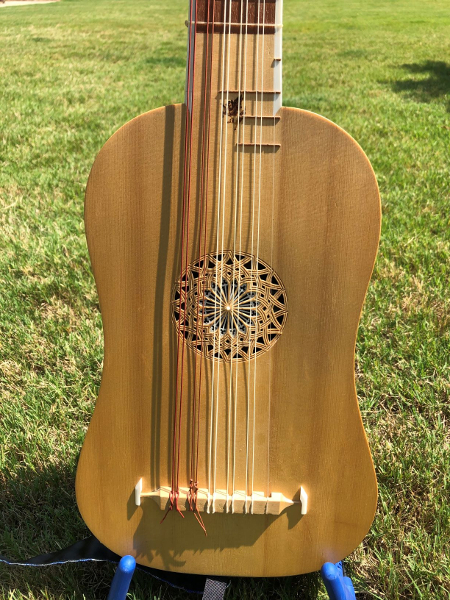
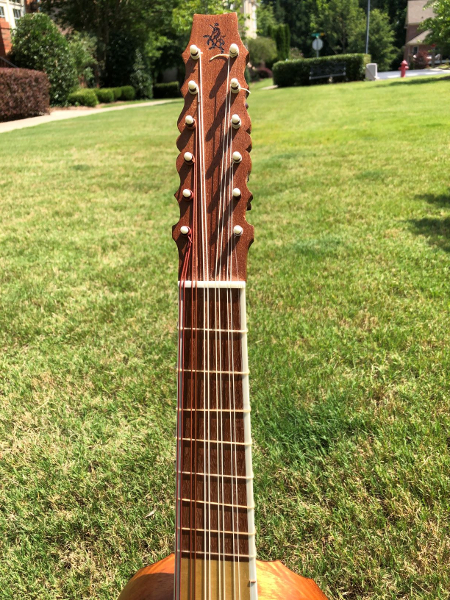
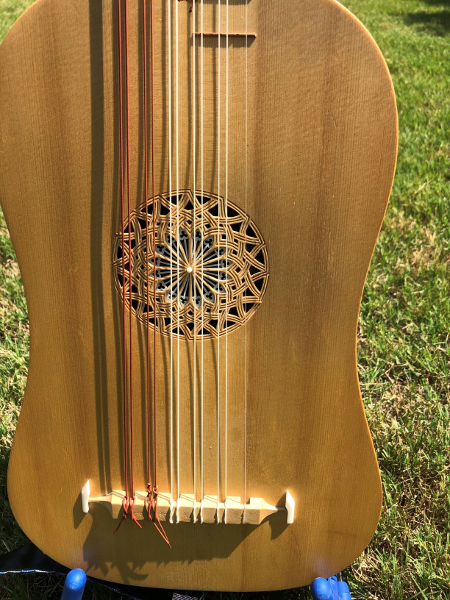
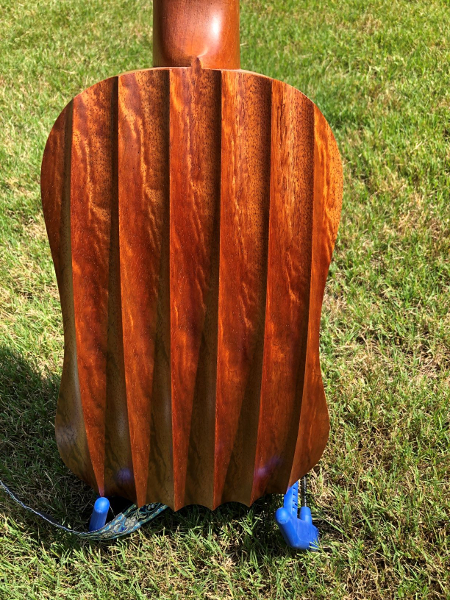
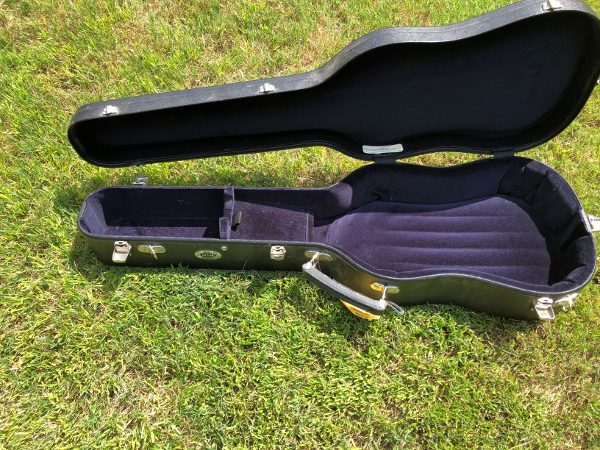
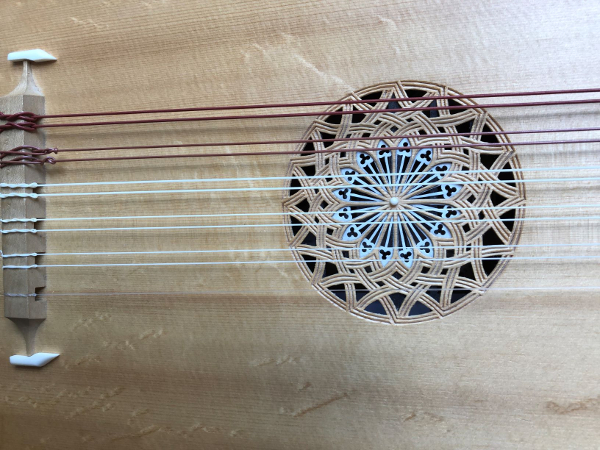
Web design copyright 2015 Michael Berger